Today in History: October 26
Mahalia Jackson
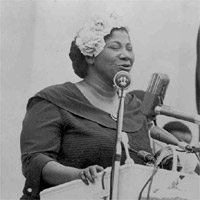
Mahalia Jackson at the Prayer Pilgrimage of Freedom,
Washington, DC, May 17, 1957
NAACP Collection,
Prints and Photographs Division
African American Odyssey
Courtesy of the NAACP
Mahalia Jackson, the "Queen of Gospel Song," was born in New Orleans, Louisiana, on October 26, 1911. Jackson grew up singing gospel music at the Plymouth Rock Baptist Church where her father preached. At age sixteen, she migrated to Chicago where she supported herself by doing housekeeping and odd jobs.
In Chicago, Jackson joined the Greater Salem Baptist Church and began touring with a gospel quintet. The beauty of her contralto voice and the increasing popularity of gospel music during the Depression brought Jackson success. She made her first recordings as a soloist in the mid-1930s for Decca and Apollo, eventually signing with Columbia records in 1954.
Jackson resisted secular music saying, "When you sing gospel you have a feeling there is a cure for what's wrong. But when you are through with the blues, you've got nothing to rest on." Although Jackson declined to sing anything but gospel, she listened to and was heavily influenced by ragtime, jazz, and blues artists including Bessie Smith, Maime Smith, Ma Rainey, and Ida Cox.
Jackson sang regularly at Chicago's South Side Greater Baptist Church and often collaborated with Thomas Dorsey, the "Father of Gospel Music." Originally a blues musician, Dorsey began to write sacred music early in the century, using the sounds and rhythms of blues and jazz. Over the years, gospel made a lasting impact on blues and soul artists, including Aretha Franklin, who listened to Mahalia Jackson sing at Rev. C. L. Franklin's New Bethel Baptist Church in Detroit.
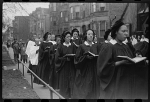
Easter Procession,
Chicago, Illinois,
Edwin Rosskam, photographer.
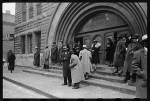
In Front of Pilgrim Baptist Church on Easter Sunday,
Chicago, Illinois,
Russell Lee, photographer
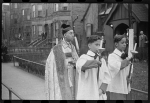
Easter Procession,
Chicago, Illinois,
Edwin Rosskam, photographer
April, 1941.
FSA/OWI Photographs, 1935-1945
Jackson hosted a radio program in Chicago for CBS, and often her powerful voice concluded the day's local television broadcast. She recorded with Duke Ellington, packed Carnegie Hall on a number of occasions, and sang for four presidents.
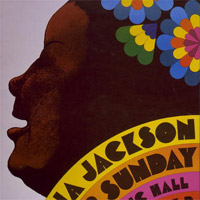
Mahalia Jackson - Easter Sunday - Philharmonic Hall, Lincoln Center.
Security Printing Company,
1967.
Prints and Photographs Division.
Jackson lent her prestige to the civil rights movement and became a prominent figure in the struggle. In 1955, she supported the Montgomery, Alabama bus boycott led by Dr. Martin Luther King, and, at King's request, she sang "I've Been 'Buked and I Been Scorned" just before he delivered his "I Have a Dream" speech during the 1963 March on Washington.
Jackson was sixty-years-old years old when she died in the Chicago suburb of Evergreen Park, Illinois. At her funeral, Coretta Scott King described the singer as "black…proud…[and] beautiful." She recalled her husband saying of Jackson, "A voice like this comes, not once in a century, but once in a millennium."
- Listen to gospel. "Now What a Time": Blues, Gospel, and the Fort Valley Music Festivals, 1938-1943 consists of approximately one hundred sound recordings, primarily blues and gospel songs, from the folk festival at Fort Valley State College, Georgia. "Lead Me to that Rock," "Anyhow," and "Daniel Saw the Stone" are just a few of the gospel recordings available through this collection.
- View pictures of Mahalia Jackson and Bessie Smith in Creative Americans: Portraits by Van Vechten, 1932-1964.
- Visit the online exhibition The African-American Mosaic to learn more about African-American migrations.
- Read Today in History features on other twentieth-century recording artists including Sophie Tucker, Louis Jordan, and Ella Fitzgerald.
The Erie Canal
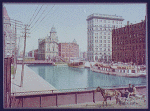
Erie Canal at Salina Street,
Syracuse, New York,
circa 1900.
Touring Turn-of-the-Century America, 1880-1920
The Erie Canal opened on October 26, 1825, providing overland water transportation between the East Coast and the Great Lakes region. Under construction for eight years, the project was the vision of New York Governor DeWitt Clinton. He convinced the New York state legislature to commit seven million dollars to the construction of a 363-mile ditch, forty feet wide and four feet deep. The canal flowed from Buffalo on the east coast of Lake Erie, through the mountains near the Mohawk Valley west of Troy, and terminated at the upper Hudson River at Albany. A tremendous success, the waterway accelerated settlement of the upper Midwest including the founding of hundreds of towns such as Clinton, in DeWitt County, Illinois.
Mr. and Mrs. Barre Stoen were among these settlers. After a fourteen-week journey from Norway to New York City, they immediately boarded a canal boat and traveled the length of the Erie Canal to Buffalo, then crossed the Great Lakes to Milwaukee, where they bought a team of oxen and headed further west. The Stoens eventually settled at Long Coulee, thirteen miles north of La Crosse, Wisconsin. The first settlers in this secluded region, the Stoens were joined shortly thereafter by other pioneers from Scandinavia. Nearly a century later, fourteen-year-old Melvina Casberg recounted the Stoens' experience including an account of the settlers' first encounter with the Native Americans of Wisconsin:
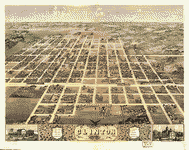
Bird's Eye View of the City of Clinton,
DeWitt County, Illinois, 1869.
Panoramic Maps, 1847-1929
One day a messenger on horseback rode over the prairie shouting fearful news to the pioneers. A band of Indians was coming directly there and they should seek places of safety. The women and children found refuge in one of the log cabins where they might be protected…The several men lay armed in the tall grass by the creek that was near their home. The tribe soon came and camped where the Holmen school now stands. After watching the Indians for a while the men decided to go and talk to them. The chief appeared very friendly, offered the peace pipe and presented various gifts. The next morning the Indians left and fear for them was gone.
Completion of the Erie Canal also stimulated the growth of New York City. Canal boats facilitated exchange of manufactured goods from the city with agricultural products from the Midwest. A 1903 actuality film from the Thomas Edison film company, Panorama Water Front and Brooklyn Bridge from East River, begins with footage of canal boats from the Erie Canal demonstrating the canal's continuing commercial importance to the port of New York at the turn of the century.
In fact, the Erie Canal remained vital well into the twentieth century. The New York State Barge Canal, completed between 1903 and 1918, incorporated the canal into a larger system of waterways that included extensions to Lake Ontario, Lake Champlain, Lake Cayuga, and Lake Seneca. Commercial use of the Barge Canal had declined by the 1980s. Since then, it has become a popular venue for pleasure boaters.
For more about the Erie Canal and the settlement of the Midwest:
- Read more about the Wisconsin village settled by the Stoen family. Search the collection American Life Histories, 1936-1940 on the term Long Coulee. American Life Histories, 1936-1940 includes several narratives recounting the experiences of immigrants who settled in Wisconsin, Illinois, and Indiana in the nineteenth century. To find their stories, browse the title lists for these states, or search the collection on pioneer.
- Additional stories of pioneer life are available through Pioneering the Upper Midwest, ca. 1820-1910. William Nowlin recounts his family's adventurous 1834 journey on the Erie Canal in The Bark Covered House…a Description of Real Pioneer Life in the Wilderness of Michigan.
- American Memory has more than 400 photographs of man-made waterways in this country and abroad. Explore these images. Search across the American Memory pictorial collections on canal.